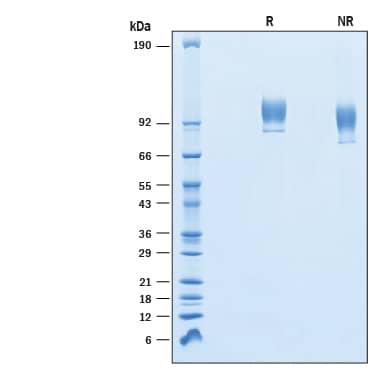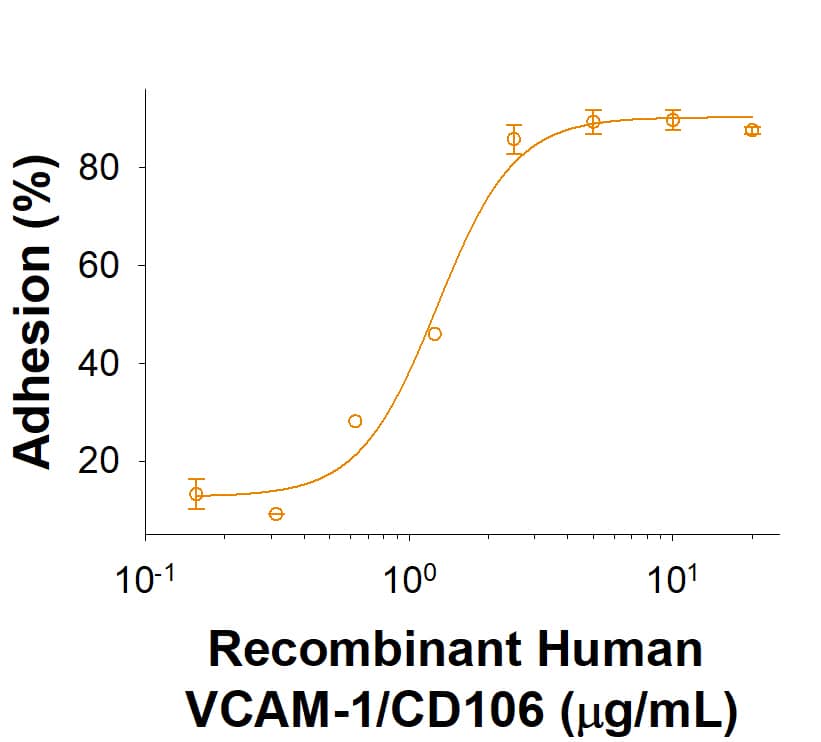Recombinant Human VCAM-1/CD106 His-tag Protein, CF
R&D Systems, part of Bio-Techne | Catalog # 10201-VC

Key Product Details
Product Specifications
Source
Chinese Hamster Ovary cell line, CHO-derived human VCAM-1/CD106 protein
Phe25-Glu698, with a C-terminal 6-His tag
Phe25-Glu698, with a C-terminal 6-His tag
Purity
>95%, by SDS-PAGE visualized with Silver Staining and quantitative densitometry by Coomassie® Blue Staining.
Endotoxin Level
<0.10 EU per 1 μg of the protein by the LAL method.
N-terminal Sequence Analysis
Phe25
Predicted Molecular Mass
75 kDa
SDS-PAGE
80-110 kDa, under reducing conditions
Activity
Measured by the ability of the immobilized protein to support the adhesion of U937 human histiocytic lymphoma cells.
The ED50 for this effect is 0.5-3 μg/mL.
The ED50 for this effect is 0.5-3 μg/mL.
Scientific Data Images for Recombinant Human VCAM-1/CD106 His-tag Protein, CF
Recombinant Human VCAM-1/CD106 His-tag Protein Bioactivity
Recombinant Human VCAM-1/CD106 His-tag (Catalog # 10201-VC) supports the adhesion of U937 human histiocytic lymphoma cells. The ED50 for this effect is 0.5-3 μg/mL.Recombinant Human VCAM-1/CD106 His-tag Protein SDS-PAGE
2 μg/lane of Recombinant Human VCAM-1/CD106 His-tag (Catalog # 10201-VC) was resolved with SDS-PAGE under reducing (R) and non-reducing (NR) conditions and visualized by Coomassie® Blue staining, showing bands at 80-110 kDa.Formulation, Preparation and Storage
10201-VC
| Formulation | Lyophilized from a 0.2 μm filtered solution in PBS. |
| Reconstitution | Reconstitute at 500 μg/mL in PBS. |
| Shipping | The product is shipped at ambient temperature. Upon receipt, store it immediately at the temperature recommended below. |
| Stability & Storage | Use a manual defrost freezer and avoid repeated freeze-thaw cycles.
|
Background: VCAM-1/CD106
References
- Vonderheide, R.H. et al. (1994) J. Cell Biol. 125:215.
- Cybulsky, M.I. et al. (1991) Proc. Natl. Acad. Sci. USA 88:7859.
- Luster, A.D. et al. (2005) Nat. Immunol. 6:1182.
- Osborn, L. et al. (1989) Cell 59:1203
- Langer. H.F. et al. 2009. J Cell Mol Med. 13:1211.
- Willeit.K. et al. 2017. JAMA Cardiol. 2:516.
- Lo Iacono.O. et al. 2008. Liver Int. 28:1129.
- Wu.T.C. et al. 2007. Cancer Research. 67:6003
Long Name
Vascular Cell Adhesion Molecule 1
Alternate Names
CD106, VCAM1
Gene Symbol
VCAM1
UniProt
Additional VCAM-1/CD106 Products
Product Documents for Recombinant Human VCAM-1/CD106 His-tag Protein, CF
Product Specific Notices for Recombinant Human VCAM-1/CD106 His-tag Protein, CF
For research use only
